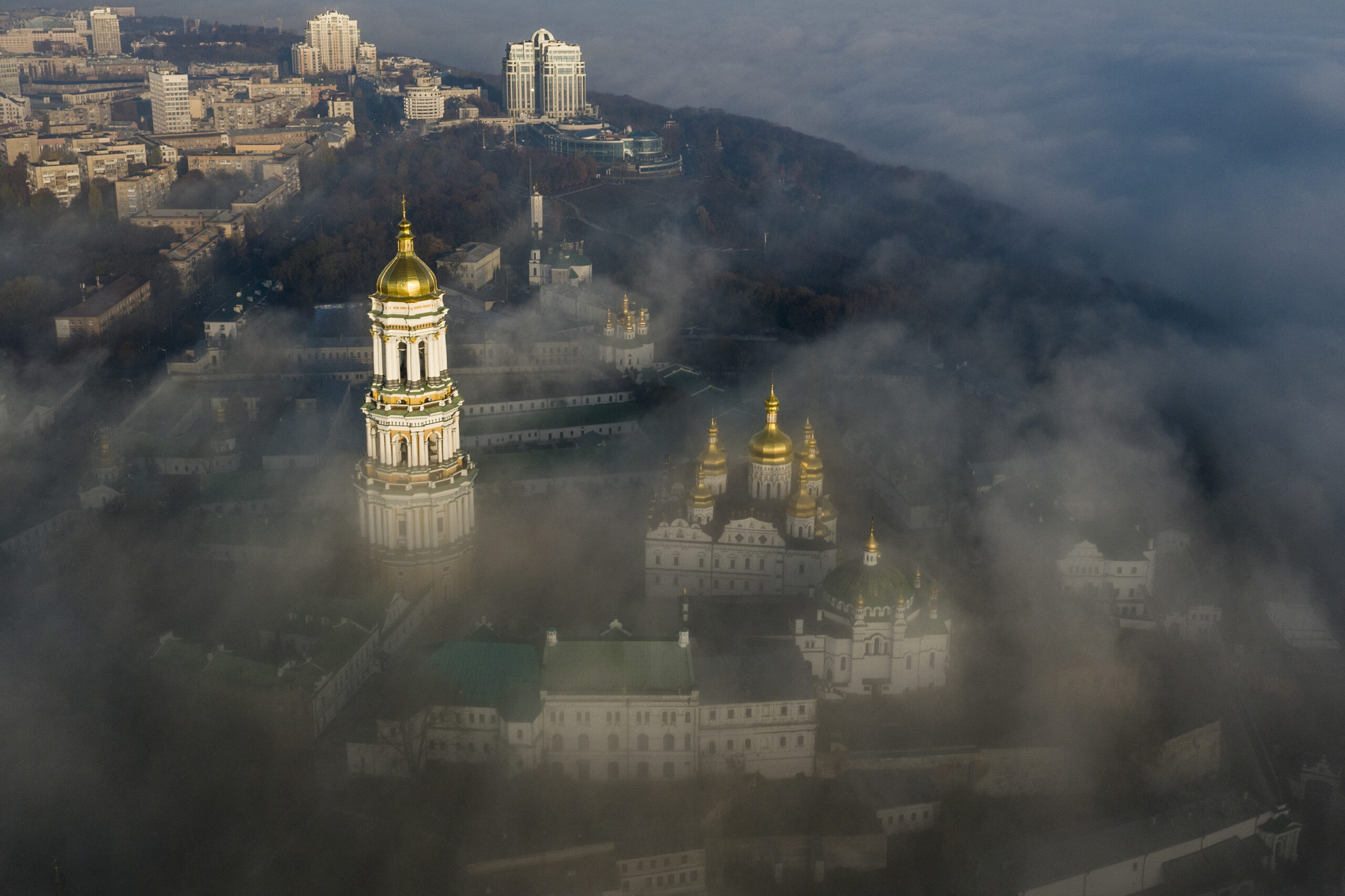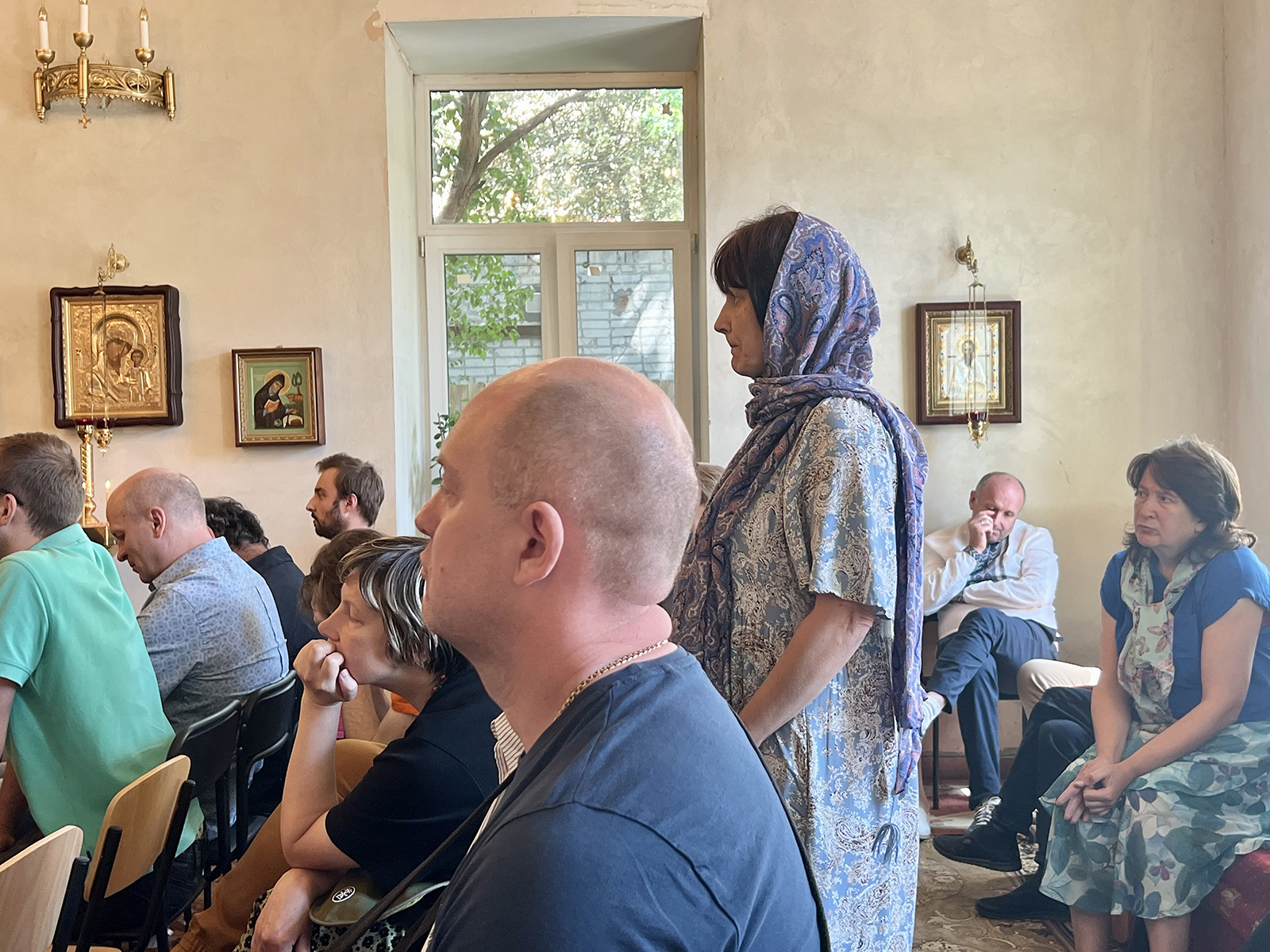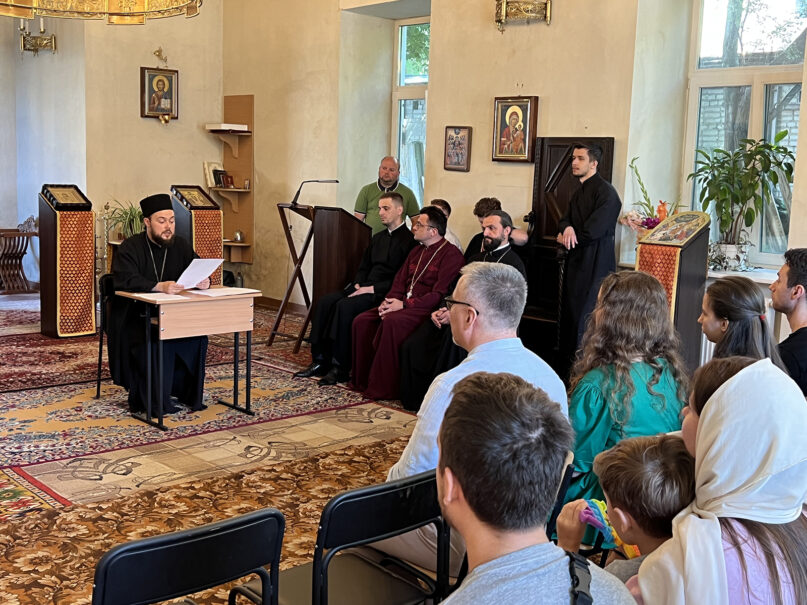LVIV, Ukraine (RNS) — On a recent Sunday, Ukrainian Orthodox Abbott Job Olshansky faced 50 stoic parishioners and presented his case for why the community should switch to the Gregorian liturgical calendar on Sept. 1.
The war in Ukraine has accelerated a restructuring of religious life across the country that aims to untangle itself from Russian influence, which has long shaped its history. The leader of the Russian Orthodox Church, Patriarch Kirill, has enthusiastically supported Russian President Vladimir Putin and the Kremlin’s view that Ukraine’s land and culture are foundationally Russian.
“The desire to preserve and affirm our own, Ukrainian, spiritual identity, protection from the aggression of the ‘Russian world,’ requires us to make a timely decision,” Olshansky told his parishioners.
For centuries, Orthodox Ukrainians saw the traditional Julian calendar as one of the anchors of their church’s identity — first as a sign of resistance to Latinization by the Catholic monarchs reigning in western Ukraine and then as resistance to the Soviet system. But in recent decades, the Julian calendar has become associated with support for Russian, not Ukrainian, Orthodoxy.
The calendar shift means millions of Ukrainians will celebrate Christmas on Dec. 25 this year instead of Jan. 7, when Russian and some other Orthodox churches celebrate. The Western Christian world adopted a revised calendar by papal decree in 1582 to correct calculations of Easter, while most of the world’s Eastern Orthodox churches began following it after a synod in 1924.
Nearly 80% of Ukrainians identify as Orthodox Christians but divide their loyalties among two rival branches. There’s the Ukrainian Orthodox Church, which has historically tied itself to the Moscow Patriarchate but claimed to untie itself in May 2022, a few months after the full-scale Russian invasion of Ukraine. And there’s the Orthodox Church of Ukraine, formally recognized as self-governing in 2019 by the Ecumenical Patriarch of Constantinople. (The first self-governing Ukrainian church formed in 1921 and was an important arm of Ukrainian nationalism, but Soviet persecution liquidated its assets, exiled clergy and forced its followers underground. Joseph Stalin revived the Russian Orthodox Church and its Ukrainian branch in 1943.)
The Moscow Patriarchate would like to hold on to the Ukrainian church because Russian Orthodoxy was birthed in Kyiv — the Ukrainian capital — and its churches account for about one-third of the Russian-based Orthodox church. To this day, it still has more registered parishes in Ukraine than the independent church.

An aerial photo shows the thousand-year-old Monastery of Caves, also known as Kiev Pechersk Lavra, the holiest site of Eastern Orthodox Christians, taken through morning fog during a sunrise in Kyiv, Ukraine, Nov. 10, 2018. (AP Photo/Evgeniy Maloletka, File)
But according to one 2022 survey, only about 4% of Ukrainians now identify with the Moscow Patriarchate, and at least 1,500 parishes have switched to the self-governing Orthodox Church of Ukraine. One impact is that more Ukrainians are hearing liturgy in Ukrainian rather than Church Slavonic, a liturgical language close to Russian.
In addition, government bans of the Russian-linked church at the local and regional levels have allowed the state, which owns many historic church buildings, to transfer leases to the newly self-governing Orthodox Church of Ukraine. A draft law under consideration by Ukraine’s Parliament could ban the older Ukrainian church. Lviv became the first city to ban it already, and dismantled what was reported to be its last remaining building in April.
RELATED: Battle over ownership of Ukrainian monastery heats up again
“One of the reasons Russia needs to control its church so much is that those who influence the church have control of the country,” said Mikhailo Sivak, a priest at Intercession of the Theotokos Orthodox Cathedral. “If there are pro-Russians in Lviv they are few and silent. The number of Orthodox Church of Ukraine churches is increasing significantly each month.”
Holy Resurrection New Athos Monastery, where Olshansky presides, was one of dozens of churches in Lviv to transition to the independent church in March last year.
Olshansky, who was hired in 2019 to assist Metropolitan Filaret of Lviv and Galicia, said he was one of only two priests at a meeting of about 20 Ukrainian Orthodox-Moscow Patriarchate clergy a few weeks after the full-scale invasion to condemn Russia’s actions. Lviv has been a cultural center of Ukrainian nationalism for centuries.
“They said it’s the Americans dropping bombs on us, and Russia is innocent,” Olshansky said. “That’s when I realized I could not keep working with these people, when my family near Irpin and Bucha were being bombed.”
A representative for Filaret declined to comment on the number of parishes making the switch due to an ongoing legal battle with the city. Laypeople in Lviv who prefer the traditional Ukrainian church are meeting secretly in their apartments for liturgies, multiple people who work for the diocese said. Religion News Service spoke to several Ukrainian Orthodox, formerly Moscow Patriarchate, church members in Kyiv who support the Ukrainian defense forces and wish their top leaders would condemn Russian aggression more strongly.
Ukrainian Orthodox Church leaders have insisted they condemn the Russian invasion and are being unfairly persecuted. Metropolitan Onuphry of Kyiv quickly declared the invasion a “disaster,” and Lviv clergy were among the first to stop commemorating Patriarch Kirill of Moscow. But the state has arrested and convicted several of the church’s clergy found to have collaborated with Russian soldiers or to have justified the Russian invasion. In addition, a Kyiv court earlier this month upheld the government’s lease cancellation at the Monastery of the Caves, a sacred site in Slavic Orthodoxy founded in 1051. Ukrainian Orthodox monks, clergy and supporters have been resisting their eviction that would cede the grounds to the independent church.

Parishioner Liudmula Ivanova stands to voice her support for a calendar reform during a parish meeting of the Holy Resurrection New Athos Monastery in Lviv, Ukraine, Aug. 13, 2023. Photo by Meagan Saliashvili
Vladkya Anthony, Metropolitan of Boryspil and Chancellor of the Ukrainian Orthodox Church, told RNS in a previous interview that the conflict with the independent church is over nationalist, not religious, lines. “They are fighting their own people, their spiritual roots,” he said. “We are not asking for any privileges, just asking to exist in a democratic state.”
Liudmula Ivanova, 55, worships at Holy Resurrection and said she switched to the independent Orthodox Church of Ukraine because the Russian Orthodox Church was condoning the killing of Ukrainians. (Sites like Russian Media Monitor show Russian clergy on an Orthodox TV channel advocating for a genocide of Ukrainians.)
“It’s not good. Russians don’t analyze. They do not think,” she said. “They just do whatever they’re told by the priest. Russian priests expected people to not resist, but we did.”
Though Lviv is hundreds of miles from the front lines and close to the border with Poland, Russian missiles regularly strike residential buildings and kill civilians. The latest attack, on Tuesday (Aug. 15), damaged more than 100 buildings in the region and killed three people, including a 10-year-old.
At the end of July, leaders of the new Orthodox Church of Ukraine voted to introduce the Gregorian calendar, but parishes must win two-thirds of their members’ votes to adopt it.
Not everyone is excited about the calendar change. Pavlo Davydenko, a priest at Holy Resurrection, said adopting the new calendar would cut the monastery off from people praying in their homes and could drag the church closer to the Vatican, which he feared could water down Orthodoxy.
“It’s one thing to do it and another to believe in it,” he said. “We should give people more time to switch to the new calendar, to get used to the idea.”
Just a few months ago, the community’s Telegram chat showed only about half of the parishioners were on board with switching to the Gregorian feast days and holidays, which feel Western and foreign to them.
“We had to get used to praying in Ukrainian,” Olshansky said. “It didn’t happen in one day, and the calendar process should happen step by step.” He believes that the newly formed Ukrainian church is truly the people’s church and does not aspire to become a state church, while the Moscow Patriarchate and older Ukrainian church operate from the top down.
After a discussion, a vote was called, and the overwhelming majority voted to adopt the new calendar, like thousands of other churches are expected to do.
RELATED: Russian patriarch reminds Africans of advantages in following Kremlin’s lead





